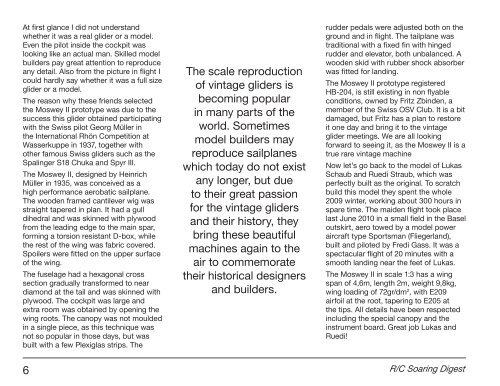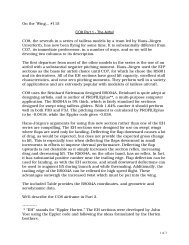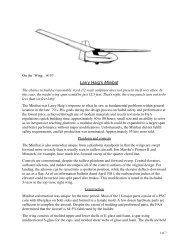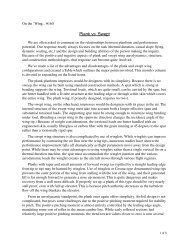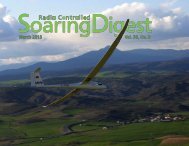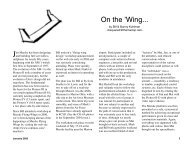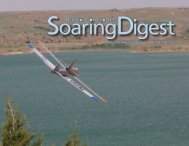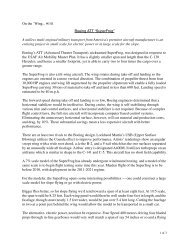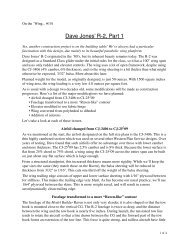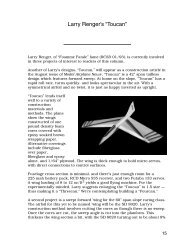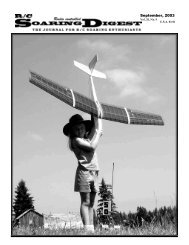Radi C ntr lled - Radio Controlled Soaring Digest
Radi C ntr lled - Radio Controlled Soaring Digest
Radi C ntr lled - Radio Controlled Soaring Digest
Create successful ePaper yourself
Turn your PDF publications into a flip-book with our unique Google optimized e-Paper software.
At first glance I did not understand<br />
whether it was a real glider or a model.<br />
Even the pilot inside the cockpit was<br />
looking like an actual man. Ski<strong>lled</strong> model<br />
builders pay great attention to reproduce<br />
any detail. Also from the picture in flight I<br />
could hardly say whether it was a full size<br />
glider or a model.<br />
The reason why these friends selected<br />
the Moswey II prototype was due to the<br />
success this glider obtained participating<br />
with the Swiss pilot Georg Müller in<br />
the International Rhön Competition at<br />
Wasserkuppe in 1937, together with<br />
other famous Swiss gliders such as the<br />
Spalinger S18 Chuka and Spyr III.<br />
The Moswey II, designed by Heinrich<br />
Müller in 1935, was conceived as a<br />
high performance aerobatic sailplane.<br />
The wooden framed cantilever wig was<br />
straight tapered in plan. It had a gull<br />
dihedral and was skinned with plywood<br />
from the leading edge to the main spar,<br />
forming a torsion resistant D-box, while<br />
the rest of the wing was fabric covered.<br />
Spoilers were fitted on the upper surface<br />
of the wing.<br />
The fuselage had a hexagonal cross<br />
section gradually transformed to near<br />
diamond at the tail and was skinned with<br />
plywood. The cockpit was large and<br />
extra room was obtained by opening the<br />
wing roots. The canopy was not moulded<br />
in a single piece, as this technique was<br />
not so popular in those days, but was<br />
built with a few Plexiglas strips. The<br />
6<br />
The scale reproduction<br />
of vintage gliders is<br />
becoming popular<br />
in many parts of the<br />
world. Sometimes<br />
model builders may<br />
reproduce sailplanes<br />
which today do not exist<br />
any longer, but due<br />
to their great passion<br />
for the vintage gliders<br />
and their history, they<br />
bring these beautiful<br />
machines again to the<br />
air to commemorate<br />
their historical designers<br />
and builders.<br />
rudder pedals were adjusted both on the<br />
ground and in flight. The tailplane was<br />
traditional with a fixed fin with hinged<br />
rudder and elevator, both unbalanced. A<br />
wooden skid with rubber shock absorber<br />
was fitted for landing.<br />
The Moswey II prototype registered<br />
HB-204, is still existing in non flyable<br />
conditions, owned by Fritz Zbinden, a<br />
member of the Swiss OSV Club. It is a bit<br />
damaged, but Fritz has a plan to restore<br />
it one day and bring it to the vintage<br />
glider meetings. We are all looking<br />
forward to seeing it, as the Moswey II is a<br />
true rare vintage machine<br />
Now let’s go back to the model of Lukas<br />
Schaub and Ruedi Straub, which was<br />
perfectly built as the original. To scratch<br />
build this model they spent the whole<br />
2009 winter, working about 300 hours in<br />
spare time. The maiden flight took place<br />
last June 2010 in a small field in the Basel<br />
outskirt, aero towed by a model power<br />
aircraft type Sportsman (Fliegerland),<br />
built and piloted by Fredi Gass. It was a<br />
spectacular flight of 20 minutes with a<br />
smooth landing near the feet of Lukas.<br />
The Moswey II in scale 1:3 has a wing<br />
span of 4,6m, length 2m, weight 9,8kg,<br />
wing loading of 72gr/dm 2 , with E209<br />
airfoil at the root, tapering to E205 at<br />
the tips. All details have been respected<br />
including the special canopy and the<br />
instrument board. Great job Lukas and<br />
Ruedi!<br />
R/C <strong>Soaring</strong> <strong>Digest</strong>


